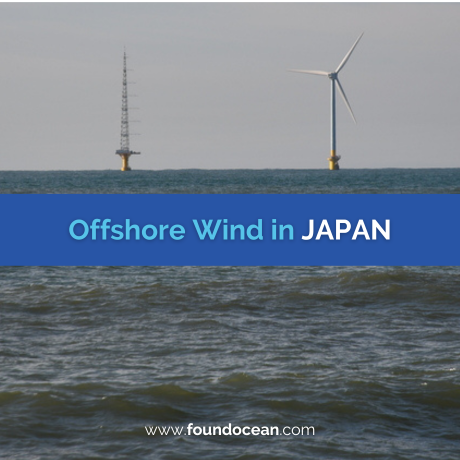
Offshore Wind in Japan
The offshore wind boom in Japan
Japan is often regarded as a nation of technological innovation and forward thinking and right now their attention is being directed towards their burgeoning offshore wind sector. In February 2023, the country’s first large-scale offshore wind project began commercial operation at Noshiro Port in Akita Prefecture, with a total capacity of 140MW. Comprised of 33 turbines, the site is capable of providing enough energy to power around 120,000 homes.
Their growing industry is the result of government targets as part of the global energy transition. Japan wants renewables to provide 36-38% of its electricity by 2030, with 10GW of offshore wind capacity installed in this time. By 2040, they aim to have a total of 45GW of offshore wind installed, with a target of becoming carbon neutral by 2050.
The offshore wind sector is booming worldwide, with many countries developing their infrastructure and installing their first offshore wind sites. In the USA, for example, South Fork wind, one of their first offshore wind developments, started delivering its first power at the end of 2023. In the Asia-Pacific region, Taiwan, another island nation, has been a leader in offshore wind for several years. With new planned developments, Japan could soon catch up or even overtake Taiwan.
Offshore wind potential
As an island nation, Japan has enormous offshore wind potential. This is due both to its large sea territory, thanks to its 30,000 km coastline, and the high winds surrounding the country – particularly in the north, around Hokkaido prefecture. In Akita prefecture, where the first commercial wind farm stands, average annual average wind speeds range roughly between 23.4 kph and 30.6 kph, with relatively stable wind direction, making it ideally suited for the development of offshore wind infrastructure.
Image Source: Global Wind Atlas
According to the International Energy Agency (IEA), the total technical potential for offshore wind generation in Japan is around 9,000 TWh/year, over nine times its projected electricity demand in 2050! Utilising this offshore wind resource could dramatically improve Japan’s self-sufficiency, reducing their reliance on imported fuel, particularly natural gas.
In 2019, according to the World Energy Balance Overview, Japan was the least self-sufficient of the ten largest OECD (Organisation for Economic Co-operation and Development) countries, so now the development of offshore wind infrastructure could improve this significantly. The IEA suggests that 1GW of offshore wind capacity would reduce Japan’s fuel bill by over $300 million. That is no small sum!
Why now?
In the Asia-Pacific region, Japan has not been a frontrunner in offshore wind projects, but the tide is turning. Right now, new advances in technology which suit Japan’s conditions are driving the sector, namely, floating wind farms and upgraded grid connections.
In order to support a thriving offshore wind industry, efficient energy infrastructure is vital. In 2015, Japan established the Organization for Cross-regional Coordination of Transmission Operators (OCCTO) to connect and standardise the two separate grids in the country. This project, already underway, will allow for strategic planning of grid upgrades, interconnections and expansion. Improving the grid will accommodate the booming offshore wind industry, as well as other developments in the energy sector, supporting Japan’s net-zero targets. Their current Strategic Energy Plan calls for non-fossil fuel power supply sources (including nuclear) to provide roughly 60% of the country’s electricity mix by the year 2030-31.
A combination of bottom-fixed and floating turbines
Historically, the dominant type of offshore wind turbine is bottom-fixed, and they are installed in water depths of around 50m on average. In Europe, where waters are relatively shallow, this has driven development of the offshore wind sector, led by industry-leaders, the UK and Germany. Whilst Japan does have some shallow seabed area, with the potential to generate around 40 TWh/year, much of their other offshore wind potential is in deeper waters, more suitable for floating turbines.
Floating turbines are a much newer development in offshore wind technology, with only 14 fully operational floating wind farms to date, even though the world’s first ‘large capacity’ floating wind turbine, Hywind Scotland, became operational in 2017. Most floating wind projects worldwide are still in their planning stages. According to the RenewableUK report published in October 2023, “Globally, 46MW are under construction (3 projects), 576MW are consented or in the pre-construction phase (11 projects), 68GW are in the planning system or have a lease agreement (80 projects), and 175GW are in early development or applying for a lease (177 projects).”
Floating turbines can be installed at depths of up to 300m which would allow Japan to explore its huge offshore wind potential. Indeed the country already has 5MW of small floating demonstration projects – putting this type of offshore wind infrastructure to the test.
Image Source: Fukushima FORWARD – offshore wind farm demonstration project turbine
According to the Global Wind Energy Council (GWEC), if Japan utilises both forms of offshore wind, they estimate that there could be approximately 128GW capacity for bottom fixed projects and 424GW for floating offshore wind.
At time of writing, RWE has told Reuters that it plans further expansions into Japan’s offshore wind sector after winning – as part of a consortium – a 684MW wind farm project in Niigata prefecture which should be operational by 2029. It will certainly be fascinating to see what happens next in Japan, and the Asia-Pacific region as a whole.
For more information on FoundOcean’s experience and capabilities, contact the team on +44 1506 440330 or email info@foundocean.com

